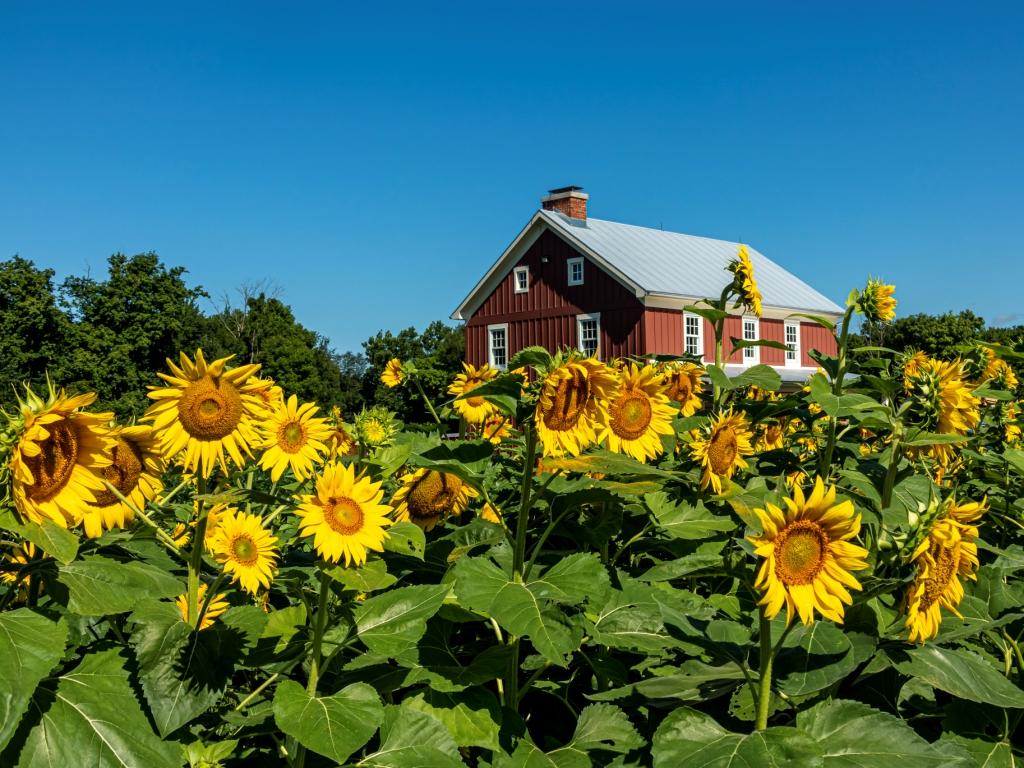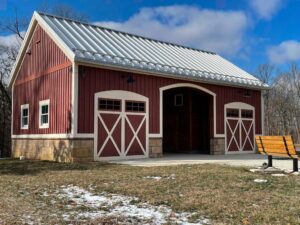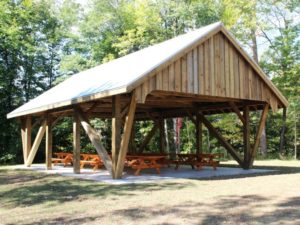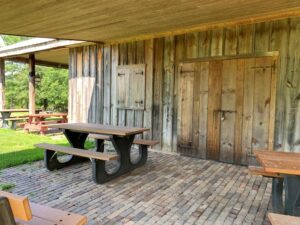Smeck Park
Location
7395 Basil Rd
Baltimore, OH 43105
Hours
Open Year-Round, Dawn to Dusk
About the Park
76+ acres in Liberty Township in the northern part of the county.
The site was first acquired in 1999 by donation (48+ acres) from Harold Smeck. An additional 28 acres were purchased from the Smeck family in 2023.

Sunflower Field near Cruit House
Some of the activities you can enjoy at this park are viewing the Stover windmill, Cruit House, and Fetter-Hood Barn, bird watching and nature observation, photography, hiking or walking, dog walking, playing in the mown grassy areas, picnicking.
There are deep ravines, open meadows, woodlands with mature, mixed hardwood trees, a Civilian Conservation Corps pine plantation, and crop fields that are tended by Fairfield County Antique Tractor Club. A portion of the property is bordered by Walnut Creek.
The park’s topography shows the effects of Ohio’s last great glacier, the Wisconsinan, that began its retreat some 14,000 years ago. The glacier flattened hills and filled in valleys. As it melted, it produced torrents of water rushing from its face that cut into the landscape leaving behind the ravines present today. Another reminder of the park’s ice-covered past is the large, granite boulder located along Goldenrod Trail. Considered a glacial erratic, it was transported thousands of miles from its original source by the glacier and left behind when the ice melted.
A large, open-air picnic shelter, patterned after Rock Mill Covered Bridge, is available for use on a first-come basis. See more about the shelter in the Shelter & Facilities section, below.
Park Features
Just short of 60′ high, with a 750-gallon water tank resting on a platform 30′ above ground, the windmill is an impressive sight.
It was built in the late 1800s by Stover Windmill Company of Freeport, Illinois, and was installed on the Roger Wolfe farm on Canal Road. In 2016, it was moved to Smeck and rebuilt.
Most of it is original but a new fan and motor had to be built. The fan is 10′ in diameter. The move and restoration was completed in 2016.
Read more about the Stover Windmill.
In 2019, visitors noticed many updates and changes including a roadway through the park, a new parking area near the picnic shelter, extensions to the trails, steps from the ridge to the ravine and Walnut Creek, and Cruit House, the beautifully restored, 200-year-old log-framed house (see below). There was to be another new addition!
Fetter-Hood Barn was deconstructed in 2005-06 at its original location on OH-37 just north of Lancaster and put into storage. The massive foundation stones were moved to and reset at Smeck Park. One corner stone is engraved with the words, “Thomas Fettr 1841”; there is no second E in Fettr. For many years, the foundation sat, bare, and was a curiosity to visitors who did not know its purpose. Construction of the barn was to begin in 2015 but was delayed due to financial constraints.
The original 1841 barn was a large, double-forebay bank barn. A forebay is an area where the walls overshoot the foundation; that barn had front and back forebays. A bank, or banked barn, refers to a barn that was usually built on a hill and has an earthen ramp to the main floor. Animals were housed at ground level. The main level was typically used for equipment storage, as a workshop, tack storage, and other uses. The loft, called a mow (rhymes with now), was used for hay storage. That Pennsylvania German-style barn was a common construction method used in the 1700-1800s.

Fetter-Hood Barn (November 2023)
Long-awaited construction of Fetter-Hood Barn (watch slideshow) began in summer 2020. Really, the barn is brand new, a replica rather than a reconstruction. The original wood was not solid enough to use in a rebuild. To meet current construction standards, a second foundation had to be built inside the original foundation to support the massive structure and make it safe for non-agricultural use. The heavy-timber framework was precut offsite then shipped, August 3, to the park to be assembled. By August 12, it was partially finished and soon under roof. Work was completed in 2021.
Read more about the Fetter-Hood Barn.
English immigrants, William and Hanna (Moon) Cruit, arrived in Fairfield County in 1829. They constructed this house in Section 24 of Greenfield Township. Jacob and Mary (Bryant) Wagner purchased the home in 1886. It remained in the possession of their descendants through the 19th and 20th centuries. Then, the Reef-Beck family owned and occupied the home for over one hundred years, until 2019 when it was relocated to this site at Smeck Park.
See photos and read more about the history of Cruit House.
Waterways
Walnut Creek

Walnut Creek | Photo by Josh Zielinski
According to the Ohio EPA (State of Ohio Environmental Protection Agency), February 2010 Walnut Creek Watershed TMDL Report, the “Walnut Creek watershed in central Ohio covers all or part of five counties. Beginning in Perry County just to the southwest of Thornville, Walnut Creek flows west for 58 miles to join the Scioto River in Pickaway County.” Its tributary streams are Pawpaw, Poplar, Sycamore, Georges, and Little Walnut Creeks, and Turkey Run and Mud Run.
Trails
Printable Smeck Park Trail Map
Paw Paw Trail

Walnut Creek Trail | Photo by Josh Zielinski
This 1.5-mile trail combines with Walnut Creek Trail to make a two-mile loop. It is a natural, unpaved trail that may be considered moderate, going along ridges, ravines and meadows. Hikers can expect to see ephemeral spring wildflowers, sycamore trees, a stand of CCC-planted pine trees, paw paw trees, and encounter birding opportunities. Pets on leash are welcome.
Walnut Creek Trail
This 0.5-mile trail combines with Paw Paw Trail to make a two-mile loop. It is a natural, unpaved trail that may be considered moderate, with steps to a ravine and through a meadow. Hikers can expect to see ephemeral spring wildflowers, sycamore trees, a forested area, and Walnut Creek.
Shelters & Facilities
Open-Air Picnic Shelter
Reservations: No. Available daily on a first-come basis at no charge.
Accessibility: Gravel Path, Mowed Grass
Distance from Parking Lot: ~1,000′
Electricity: Yes
Charcoal Grill: Yes
Description: This open air picnic shelter has eight 8′ picnic tables and will seat approximately 48-64 people.
Enclosed Shelter House
Reservations: No. Available daily on a first-come basis at no charge.
Accessibility: Mowed Grass
Distance from Parking Lot: ~300′
Electricity: No
Charcoal Grill: No
Description: Picnic tables in the exterior covered patio spaces may be used. The enclosed interior of the shelter house is restricted to park program use only.
Picnic Tables
There are picnic tables located throughout the park.

Restrooms at Smeck Park
Restrooms
Type: Permanent, running-water fixtures, open year-round.
Water: Yes (non-potable)
Smeck Park
Location
7395 Basil Rd
Baltimore, OH 43105
Hours
Open Year-Round, Dawn to Dusk
About the Park

Sunflower Field near Cruit House
76+ acres in Liberty Township in the northern part of the county.
The site was first acquired in 1999 by donation (48+ acres) from Harold Smeck. An additional 28 acres were purchased from the Smeck family in 2023.
Some of the activities you can enjoy at this park are viewing the Stover windmill, Cruit House, and Fetter-Hood Barn, bird watching and nature observation, photography, hiking or walking, dog walking, playing in the mown grassy areas, picnicking.
There are deep ravines, open meadows, woodlands with mature, mixed hardwood trees, a Civilian Conservation Corps pine plantation, and crop fields that are tended by Fairfield County Antique Tractor Club. A portion of the property is bordered by Walnut Creek.
The park’s topography shows the effects of Ohio’s last great glacier, the Wisconsinan, that began its retreat some 14,000 years ago. The glacier flattened hills and filled in valleys. As it melted, it produced torrents of water rushing from its face that cut into the landscape leaving behind the ravines present today. Another reminder of the park’s ice-covered past is the large, granite boulder located along Goldenrod Trail. Considered a glacial erratic, it was transported thousands of miles from its original source by the glacier and left behind when the ice melted.
A large, open-air picnic shelter, patterned after Rock Mill Covered Bridge, is available for use on a first-come basis. See more about the shelter in the Shelter & Facilities section, below.
Park Features
Just short of 60′ high, with a 750-gallon water tank resting on a platform 30′ above ground, the windmill is an impressive sight.
It was built in the late 1800s by Stover Windmill Company of Freeport, Illinois, and was installed on the Roger Wolfe farm on Canal Road. In 2016, it was moved to Smeck and rebuilt.
Most of it is original but a new fan and motor had to be built. The fan is 10′ in diameter. The move and restoration was completed in 2016.
Read more about the Stover Windmill.
In 2019, visitors noticed many updates and changes including a roadway through the park, a new parking area near the picnic shelter, extensions to the trails, steps from the ridge to the ravine and Walnut Creek, and Cruit House, the beautifully restored, 200-year-old log-framed house (see below). There was to be another new addition!
Fetter-Hood Barn was deconstructed in 2005-06 at its original location on OH-37 just north of Lancaster and put into storage. The massive foundation stones were moved to and reset at Smeck Park. One corner stone is engraved with the words, “Thomas Fettr 1841”; there is no second E in Fettr. For many years, the foundation sat, bare, and was a curiosity to visitors who did not know its purpose. Construction of the barn was to begin in 2015 but was delayed due to financial constraints.
The original 1841 barn was a large, double-forebay bank barn. A forebay is an area where the walls overshoot the foundation; that barn had front and back forebays. A bank, or banked barn, refers to a barn that was usually built on a hill and has an earthen ramp to the main floor. Animals were housed at ground level. The main level was typically used for equipment storage, as a workshop, tack storage, and other uses. The loft, called a mow (rhymes with now), was used for hay storage. That Pennsylvania German-style barn was a common construction method used in the 1700-1800s.

Fetter-Hood Barn (November 2023)
Long-awaited construction of Fetter-Hood Barn (watch slideshow) began in summer 2020. Really, the barn is brand new, a replica rather than a reconstruction. The original wood was not solid enough to use in a rebuild. To meet current construction standards, a second foundation had to be built inside the original foundation to support the massive structure and make it safe for non-agricultural use. The heavy-timber framework was precut offsite then shipped, August 3, to the park to be assembled. By August 12, it was partially finished and soon under roof. Work was completed in 2021.
Read more about the Fetter-Hood Barn.
English immigrants, William and Hanna (Moon) Cruit, arrived in Fairfield County in 1829. They constructed this house in Section 24 of Greenfield Township. Jacob and Mary (Bryant) Wagner purchased the home in 1886. It remained in the possession of their descendants through the 19th and 20th centuries. Then, the Reef-Beck family owned and occupied the home for over one hundred years, until 2019 when it was relocated to this site at Smeck Park.
See photos and read more about the history of Cruit House.
Waterways
Walnut Creek

Walnut Creek | Photo by Josh Zielinski
According to the Ohio EPA (State of Ohio Environmental Protection Agency), February 2010 Walnut Creek Watershed TMDL Report, the “Walnut Creek watershed in central Ohio covers all or part of five counties. Beginning in Perry County just to the southwest of Thornville, Walnut Creek flows west for 58 miles to join the Scioto River in Pickaway County.” Its tributary streams are Pawpaw, Poplar, Sycamore, Georges, and Little Walnut Creeks, and Turkey Run and Mud Run.
Trails
Printable Smeck Park Trail Map
Paw Paw Trail

Walnut Creek Trail | Photo by Josh Zielinski
This 1.5-mile trail combines with Walnut Creek Trail to make a two-mile loop. It is a natural, unpaved trail that may be considered moderate, going along ridges, ravines and meadows. Hikers can expect to see ephemeral spring wildflowers, sycamore trees, a stand of CCC-planted pine trees, paw paw trees, and encounter birding opportunities. Pets on leash are welcome.
Walnut Creek Trail
This 0.5-mile trail combines with Paw Paw Trail to make a two-mile loop. It is a natural, unpaved trail that may be considered moderate, with steps to a ravine and through a meadow. Hikers can expect to see ephemeral spring wildflowers, sycamore trees, a forested area, and Walnut Creek.
Shelters & Facilities
Open-Air Picnic Shelter
Reservations: No. Available daily on a first-come basis at no charge.
Accessibility: Gravel Path, Mowed Grass
Distance from Parking Lot: ~1,000′
Electricity: Yes
Charcoal Grill: Yes
Description: This open air picnic shelter has eight 8′ picnic tables and will seat approximately 48-64 people.
Enclosed Shelter House
Reservations: No. Available daily on a first-come basis at no charge.
Accessibility: Mowed Grass
Distance from Parking Lot: ~300′
Electricity: No
Charcoal Grill: No
Description: Picnic tables in the exterior covered patio spaces may be used. The enclosed interior of the shelter house is restricted to park program use only.
Picnic Tables
There are picnic tables located throughout the park.

Restrooms at Smeck Park
Restrooms
Type: Permanent, running-water fixtures, open year-round.
Water: Yes (non-potable)







Social Contact